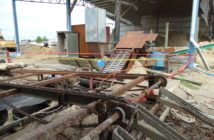There are over one million hand injuries in the United States per year according to the National Safety Council, many of which could have been avoided by using the proper equipment and tools

Industrial hand safety is crucial for working in environments where your hands are vulnerable to cuts and lacerations. Most industrial work settings include machines, cutting, lifting, and assembly. These tasks often require sharp, dangerous tools that can cause lacerations, cuts, abrasions, and bruises to the hands.
In an industrial setting, workers use their hands many times a day to perform repetitive tasks such as cutting. They can easily become distracted by thinking, “I do this every day,” resulting in a careless slip. For this reason, safety programs should always be emphasized and include reminders around the workplace, such as industrial hand safety posters.
Common Hand Injuries in the Workplace
Lacerations are among the most common hand injuries to occur on the job. They account for approximately 63% of hand injuries. They can range from a small cut or scratch on the skin surface to a severed tendon or nerve, resulting in permanent damage. Even a small cut can interfere with workflow. You know how a paper cut feels – so, think about a small cut from a blade. Although it may heal quickly, you might not be as productive for a day or two.
Punctures are another common hand injury in the workplace. This injury generally comes from handling sharp tools or machinery. Punctures can have serious consequences if not treated properly. Workers who experience a hand puncture should seek immediate medical attention even if it seems minor. One common consequence of a puncture is infection. A minor puncture can develop into a full-blown infection that can move into the joints and bones.
Hand injuries can be costly for the employee and the employer. Depending on the severity of the injury, medical costs can skyrocket, affecting you and the company’s insurance rates. According to the Occupational Safety and Health Administration (OSHA), hand injuries can cost a company over $40,000. Accidents and injuries also resulted in downtime and missed days, which can interrupt production. The Bureau of Labor and Statistics reports the average number of days missed is five; however, older workers can take from 12 to 14 days or longer to heal.
Industrial Hand Safety Tips
We don’t generally think much about our hands. We take it for granted that they’ll be operational from the time we get up in the morning to the time we go to bed at night. At least, until we sustain a hand injury. Try completing a small task like brushing your teeth or fixing a sandwich. Not hard, right? But try it using one or two fingers instead of your whole hand. A lot more challenging! It now becomes clear how vital our hands are in daily life.
Here are some industrial hand safety tips that can help protect employees in the workplace.
- Identify and eliminate hazards – this can be accomplished by modifying tools and equipment when possible.
- Training – lack of effective training is often the cause of accidents and injuries in the workplace. Training, such as industrial hand safety videos, should be incorporated into the safety culture regularly – not just as a one-time PowerPoint presentation.
- Use cut-resistant gloves – many workers complain about wearing other types of gloves because of the lack of grip, bulkiness, and sweatiness that they experience. Cut resistant materials can be thin and comfortable; investigate to find gloves your workers will actually wear.
- Stay focused – while working with dangerous tools or machinery, stay focused on the task and keeping your hands safe.
- Check your tools – are you using the most efficient tools? Make sure your tools are working properly, and safety devices are secure.
- Reinforce policies and procedures – often, workers may try to take shortcuts when performing tasks. Policies and procedures are in place to protect the workers and the employer.
Improve Hand Safety with Safer Cutting Tools
Standard cutting tools are dangerously sharp when they come from the manufacturer. This sharpness is intended to extend a metal blade’s longevity. These blades tend to dull quickly. A dull blade puts your hands at risk just as much as an overly sharp blade. It requires more force, which can result in a slip of the knife.
A blade doesn’t have to be overly sharp to cut effectively. There are safer alternatives that will protect your hands while still getting the job done efficiently. Some handles also provide good ergonomics to protect against things like sprains.



